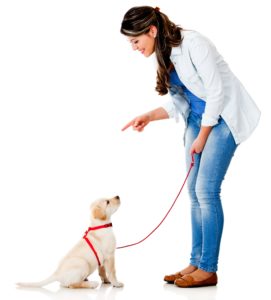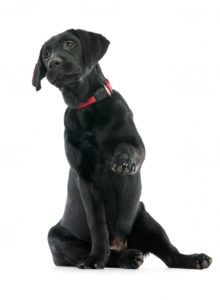Just Labs Online Feature: Let your Lab Puppy be your Teacher
By Beverley Courtney
 New owners will tell me proudly that their 10-week-old puppy can sit and stay. I think they are hoping to impress me with their own and their pup’s cleverness. But I’d really rather hear them say, “We have fantastic games of chase and tug that end up with us all helpless with laughter and the puppy quite tuckered out, lying flat on the carpet.”
New owners will tell me proudly that their 10-week-old puppy can sit and stay. I think they are hoping to impress me with their own and their pup’s cleverness. But I’d really rather hear them say, “We have fantastic games of chase and tug that end up with us all helpless with laughter and the puppy quite tuckered out, lying flat on the carpet.”
There’s lots of time to teach sit and stay. They are, of course, important! But let’s get to know and love our puppy first.
New puppy-owners are well-intentioned, but can get caught up in a controlling mindset. They make the big mistake of trying to restrict their puppy’s activities, thinking they know best. It’s all “No,” “Stop,” “Don’t …”
What A Chance They’re Missing!
If owners could only look at the world through their puppy’s eyes, uncontaminated by social norms, history, should and should not’s, they would enjoy the whole process infinitely more.
Puppies have just arrived into our wonderful world. When they move to their new home they’ve been on the planet only a few weeks – everything is a marvel. A butterfly fluttering past or a scrap of paper on the floor has the same curiosity value to them. (They’ll probably try to catch and eat both.) Working with new puppy owners for years has given me an insight into their thought processes – and those of their pups!
While we want to protect the puppy at the same time as protecting our other assets – carpets, children’s legs, electric cables – we can do this with gentle guidance approach rather than the heavy hand of no.
If you focus on deficiencies and limitations, you will hinder your puppy’s social development and miss out on all the fun of why you got a puppy in the first place!
The Zoomies
I’m frequently asked how to prevent a young dog from going on a puppy rampage of high-speed racing, spinning and jumping, leaping over the sofa, skidding round the table. This is known in the trade as a FRAP – a Frenetic Random Activity Period – or just “getting the bugs out.”
Instead of limiting my pup’s expression of his joy, I answer that not only do I thoroughly enjoy watching my puppy do this, but encourage it by clearing a path and opening doors wide so the pup can hurtle safely.
More than that, I keep this puppy behavior (which would normally die out as the dog grows up) alive and active. And I rejoice to watch my big dogs fly out to the garden, skid round the apple tree, hurtle back through the door, leap over an armchair, and onto a dog bed, hotly pursued by the smaller dogs trying to keep up, then zoom out again for another circuit round the tree, back into the house, and so on.
Such abandonment to the pleasure of physical activity – at any age – is something we could all aspire to! And enjoying this aspect of your puppy is something to look for in all your interactions.
Caring Should Include Empathy
 Research says that caring for children and grandchildren enhances people’s lives, diminishing the chance of age-related illnesses taking hold. No kids or grandchildren? No problem!
Research says that caring for children and grandchildren enhances people’s lives, diminishing the chance of age-related illnesses taking hold. No kids or grandchildren? No problem!
Whatever your life stage, your puppy will keep you fit, active, outgoing, adventurous, and most importantly, open minded.
The earlier you start teaching your puppy the better – puppies of a few weeks old are like sponges for learning. But did you know that getting your puppy to think and problem-solve will use up his energy faster than a walk? Make your teaching into an interactive game where the puppy gets huge rewards for working out the answer.
Not only will your puppy learn much faster, but he’ll learn to learn, and learn that learning is fun.
Who wants to be the big bad grump who’s always scolding the puppy? Far better to interrupt something you don’t want to see with a gentle “What else can you do for me?” or “Is that really what you’re meant to be doing?” and see if your puppy offers you attention, or a sit, or a momentary stillness while he listens to you. And thinks.
Once he’s stopped doing what you didn’t want, you can reward him with your attention, a treat, or a game!
Practice Makes Perfect
The best way to make something a habit is to keep doing it. So you want to make it super-easy for your puppy to do the things you like and earn a reward, and difficult or impossible to do the things you don’t like. Keeping him in the same room as you unless he’s safe asleep in his crate is a very good way to monitor behavior without any need for tellings-off.
Your puppy has arrived in this world with no knowledge of our strange rules and practices. But he will fit in and aim to please you! He just needs to be shown the way. Engagement with you is, after all, the highlight of his life. Parents do this instinctively with their small children. They don’t bark commands at them and expect them somehow to know what is wanted. They teach, they show, they guide, they love and cherish. The exact same approach will get the results you want from your new puppy. (It will also open you up to getting the best out of your everyday dealings with family, friends, and work colleagues.) Treat your puppy as you would treat a toddler, and explore the world with him, rewarding what you like, ignoring what you don’t like, and managing what you can’t ignore.
And it will free your mind to enjoy your puppy’s beauty, his energy, and his absolute cuteness!
Beverley Courtney, author of the forthcoming book Calm Down! Six Steps to a Relaxed, Calm and Brilliant Family Dog, lives in Worcestershire with her four dogs, cat, hens, and many tropical fish. She mainly works with puppies and “growly” dogs, always looking to build the bond between dog and owner. Get your free dog training series Top Tips for Turning Your Wild Puppy into a Brilliant Family Dog – a step-by-step guide to changing the things you don’t like about your dog to the things you do like.Find more ways to enhance your life with your new puppy at www.BrilliantFamilyDog.com.

